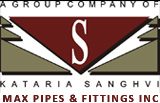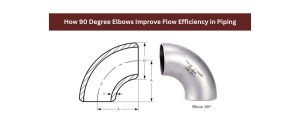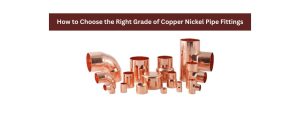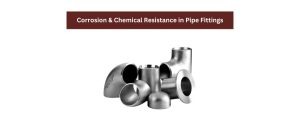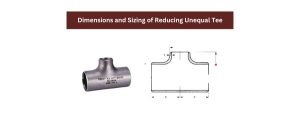A short radius elbow is a critical pipe fitting used to redirect the flow of liquids, gases, or slurries in a piping system. It typically changes the flow direction by 90 degrees or 45 degrees. The term “short radius” refers to the curvature of the elbow, which is tighter than that of a long radius elbow. Specifically, the radius of curvature is equal to the nominal diameter of the pipe (R = 1D). For example, if the pipe has a 4-inch diameter, the centerline radius of the elbow will also be 4 inches.
This shorter radius results in a compact fitting that is ideal for piping systems where installation space is limited. However, this compactness comes at a cost — the tight bend leads to increased turbulence and a higher pressure drop compared to long radius elbows.
Short radius elbows are widely used in high-pressure systems, compressed air lines, and systems where the change in direction needs to be accomplished in a minimal footprint. They are also used in places where the piping is exposed and aesthetics play a role — the compact curve can offer a sleeker appearance.
Where is a Short Radius Elbow Used and Why?
The short radius elbow finds its use in numerous industries, especially where space-saving and design compactness are critical. Here are some of the key applications and reasons for its usage:
1. Limited Space Installations
Short radius elbows are preferred in installations where the space between equipment or along walls and corners is restricted. This includes:
- Skid-mounted equipment where every inch of space counts.
- Marine and shipbuilding where pipe runs are compact and often confined to narrow spaces.
- Power plants where tight routing of pipes through boilers and heat exchangers is required.
2. Cost Efficiency in Layout
In certain projects, using a short radius elbow can reduce the overall length of pipe required, saving on material costs. They also reduce the number of supports needed because the system is more compact.
3. Dynamic Flow Systems
In hydraulic or pneumatic systems where a rapid change in flow direction is necessary, short radius elbows offer quicker transitions. They are frequently seen in:
- High-pressure steam and gas lines
- Air compressor lines
- Chemical processing loops
4. Underground and Buried Piping
Since underground installations often involve trenching, minimising the length and space required can reduce excavation costs. Short radius elbows are thus useful in buried pipelines.
Despite their advantages, one should use them cautiously in high-flow or sensitive systems, as the sudden directional change increases wear and tear on the elbow and nearby piping.
How is a Short Radius Elbow Different from a Long Radius Elbow?
Understanding the difference between a short radius and a long radius elbow is essential for selecting the right component for your piping system. Here’s a detailed comparison:
| Feature | Short Radius Elbow | Long Radius Elbow |
|---|---|---|
| Radius of Curvature | 1D (equal to nominal pipe size) | 1.5D (1.5 times the pipe size) |
| Space Requirement | Less | More |
| Pressure Drop | Higher due to sharp turn | Lower due to gradual curve |
| Flow Disruption | More turbulence | Smoother flow |
| Cost | Slightly lower due to smaller size | Slightly higher |
| Preferred Use | Tight spaces, short systems | Long runs, high-velocity fluids |
When to Use Each Type?
- Choose a short radius elbow when space is limited, and the system can handle a slightly higher pressure drop.
- Opt for a long radius elbow when maintaining a smooth flow is critical, such as in pumping systems or high-capacity pipelines.
The decision ultimately comes down to the application’s pressure rating, flow sensitivity, spatial layout, and cost considerations.
What Are the Available Materials and Standards for Short Radius Elbows?
To meet diverse industrial requirements, short radius elbows are manufactured in various materials. The selection of material depends on the type of fluid/gas being transported, the temperature and pressure of the system, and environmental factors like corrosion or chemical exposure.
Common Materials Include:
- Carbon Steel (A234 WPB, etc.) – Durable and cost-effective for general use.
- Stainless Steel (304, 316, etc.) – Excellent for corrosion resistance, especially in food, pharmaceutical, and chemical industries.
- Alloy Steel – Used for high-temperature or high-pressure applications.
- Nickel Alloys (Inconel, Monel) – Resistant to oxidation and chemical attack, used in harsh environments.
- Duplex/Super Duplex Stainless Steel – High strength and corrosion resistance, ideal for offshore and marine applications.
- Copper, Brass, and Bronze – Suitable for plumbing and aesthetic piping systems.
Standards and Specifications:
- ASME B16.9 – Factory-made wrought buttwelding fittings, widely used in the US and international projects.
- MSS SP-43 – Covers light-weight stainless steel butt-weld fittings.
- EN 10253 / DIN 2605 – European standards for butt-welded fittings.
- ISO standards – Applied in global projects for quality assurance and dimension consistency.
Each standard outlines tolerances, dimensions, testing procedures, and pressure ratings to ensure reliable and safe operation in piping systems.
Why Should You Consider a Short Radius Elbow in Tight Piping Layouts?
When designing a piping system, choosing the right elbow can significantly affect the efficiency, cost, and longevity of the system. Here’s why a short radius elbow might be the perfect solution for tight layouts:
1. Space Optimization
In congested environments such as ships, compact industrial units, and process skids, the available space to route piping is often minimal. A short radius elbow allows for directional changes without the need for extensive rerouting or additional fittings.
2. Lower Installation Costs
Since these elbows reduce the total pipe length and require fewer supports or brackets, installation becomes quicker and more economical. Labour costs can be lowered, especially in time-sensitive projects.
3. Suitable for High-Pressure Systems
The compact design of a short radius elbow can withstand high internal pressure more efficiently, especially when made from robust materials like alloy or stainless steel.
4. Aesthetic and Functional Design
In visible or exposed piping, such as architectural plumbing or process displays, the compact curve of a short radius elbow can contribute to a cleaner and more professional appearance.
5. Ideal for Retrofitting
In modification projects or system upgrades, where pipe rerouting options are limited, a short radius elbow can offer a plug-and-play solution for adapting the system without large-scale changes.
While there are several advantages, designers should evaluate the impact on fluid dynamics and consider wear and tear caused by turbulence. Proper maintenance, inspection, and material selection are crucial in such cases.
Conclusion
The short radius elbow is a small yet powerful component in the world of piping systems. It offers significant advantages in space-constrained layouts, cost-sensitive installations, and systems that can tolerate a slightly higher pressure drop. Whether you’re working in the oil & gas sector, chemical processing, or designing a compact water treatment plant, short radius elbows can offer the flexibility and compactness your system needs.
When selecting an elbow, always weigh factors such as space availability, flow sensitivity, material compatibility, and installation costs. A well-informed decision will not only optimize performance but also enhance the longevity of your entire piping system.
